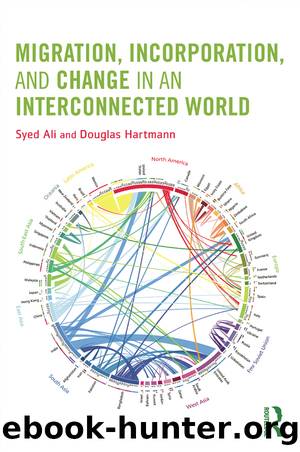Migration, Incorporation, and Change in an Interconnected World by Syed Ali Doug Hartmann

Author:Syed Ali, Doug Hartmann [Syed Ali, Doug Hartmann]
Language: eng
Format: epub
Tags: Social Science, Emigration & Immigration, Sociology, General
ISBN: 9781317556763
Google: r30cBgAAQBAJ
Publisher: Routledge
Published: 2015-01-09T02:46:10+00:00
Are Acculturation and Economic Assimilation Inevitable?
The literature on assimilation is very much the story of immigration to the West, especially to the United States. The basic assumption of all these theoretical paradigms discussed is that assimilation is likely. Classical assimilation theory assumed it would happen over time, even if that proved to be a long time. New assimilation theory also predicts that assimilation is the likely outcome for the children of immigrants, though with the twist that they will affect changes in what the cultural âmainstreamâ is. Even segmented assimilation theory, which protests against the idea that all immigrants will be upwardly mobile, argues that many immigrants will be absorbed into the middle class, others will stagnate in the working class like their parents, or they will be down-wardly mobile and be absorbed socially and economically into the lower class. These children of immigrants will eventually become culturally Americanâthe open question is how they will fare economically.
Another idea underlying these theories is about the pace at which group ethnic identity will fade as individuals and groups adapt and assimilate to life in the West. But must it happen this way? Can group identity remain distinct, and individuals truly not assimilate? There are few examples of this in the West (Hasidic Jews in New York being one), but they are relatively rare exceptions. It is better, and more useful, to look at the experiences of groups elsewhere in the world.
There is a separate, distinct literature on diasporas that shows just that. Jews, Chinese, Lebanese, and Indian merchants (among others) throughout the world have maintained distinct communities in places they settled for generations.50 Partially, this has been because of local laws, for instance those that prohibited Lebanese in Senegal, who have been present there for close to a century, from praying in Senegalese mosques or attending local Islamic schools. After Senegal became independent in 1960, some Lebanese received citizenship. Still, many Lebanese said they âwill never feel at home in Senegal,â though they are fluent in Wolof and other local languages. Second- and third-generation Lebanese still see themselves very much as Lebanese. There is very little intermarriage between them and other Senegalese by their own choice, and they actively guard against assimilation by reading books from Lebanon in Arabic, reading Lebanese newspapers, listening to Arabic music, and watching Arabic channels on TV. This is very similar to Lebanese in Cote DâIvoire who, though they may call themselves Ivoirians, think of themselves quite distinct from indigenous Ivoirians, and in fact have a superior sense of themselves and their work habits. They donât seek out social interactions with other Ivoirians and donât intermarry, something that most indigenous Ivoirians resent. They are integrated economicallyâbeing businessmen, they are organically linked in the economyâbut not socially integrated. They are a part of the society, but live mostly apart.51
The situation of Indians in the Persian Gulf is similar to that of Lebanese in Senegal and Cote DâIvoire. There are many second- and even third-generation Indians in Dubai and
Download
This site does not store any files on its server. We only index and link to content provided by other sites. Please contact the content providers to delete copyright contents if any and email us, we'll remove relevant links or contents immediately.
Cecilia; Or, Memoirs of an Heiress — Volume 1 by Fanny Burney(32023)
Cecilia; Or, Memoirs of an Heiress — Volume 3 by Fanny Burney(31437)
Cecilia; Or, Memoirs of an Heiress — Volume 2 by Fanny Burney(31382)
The Great Music City by Andrea Baker(30641)
We're Going to Need More Wine by Gabrielle Union(18607)
All the Missing Girls by Megan Miranda(14602)
Pimp by Iceberg Slim(13718)
Bombshells: Glamour Girls of a Lifetime by Sullivan Steve(13667)
Fifty Shades Freed by E L James(12886)
Talking to Strangers by Malcolm Gladwell(12816)
Norse Mythology by Gaiman Neil(12789)
For the Love of Europe by Rick Steves(11333)
Crazy Rich Asians by Kevin Kwan(8861)
Mindhunter: Inside the FBI's Elite Serial Crime Unit by John E. Douglas & Mark Olshaker(8665)
The Lost Art of Listening by Michael P. Nichols(7125)
Enlightenment Now: The Case for Reason, Science, Humanism, and Progress by Steven Pinker(6852)
The Four Agreements by Don Miguel Ruiz(6284)
Bad Blood by John Carreyrou(6255)
Weapons of Math Destruction by Cathy O'Neil(5801)
